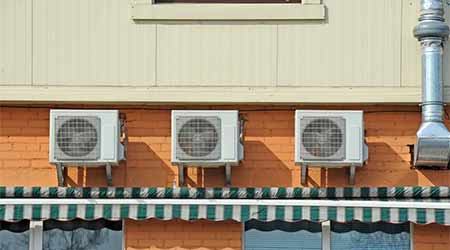HVAC: A Closer Look at VRF Technology
Part one of a three-part article on VRF technology
Variable-refrigerant flow (VRF) systems are an emerging technology in the U.S. HVAC market and are gaining the attention of maintenance and engineering managers in institutional and commercial facilities. The systems are designed to increase energy efficiency and can heat and cool separate spaces simultaneously.
A Japanese company developed VRF in the early 1980s as variable-refrigerant volume before manufacturers renamed the technology. VRF systems circulate the minimum and correct phase of refrigerant required by the indoor unit to allow for individual climate control within large air-conditioned systems.
Early-generation refrigeration HVAC systems consisted of splitting one indoor unit and one outdoor unit connected by two copper pipes. The pipes used a constant-speed compressor to circulate refrigerant.
VRF systems use a balancing box to control the heating and cooling refrigerant for each indoor unit. The basic concept separating VRF systems from other choices is the ability to vary refrigerant volume through the use of inverter-driven compressors and individual outdoor units equipped with flow-regulating valves. Varying the flow within a system allows multiple indoor room devices to be assembled into one large system, much the way central hydronic plants operate in larger facilities.
Within one system, the heating required in one room can be obtained from the heat-absorption output from another room’s cooling needs. All rooms with VRF systems feature full cooling and heating, but they provide the best energy savings when they share energy.
Indoor units feature small fans that operate quietly and do not require the use of air ducts because they are served by small refrigerant piping. Since a refrigerant’s heat capacity is higher than that of air or water, duct and fan sizes throughout buildings are reduced. Since the outdoor unit acts as a single source of heating and cooling, multiple chillers, boilers and pumps are not required to flow water through large piping systems.
In a two-pipe VRF system, up to 60 room devices can connect to one balancing box. A set of valves inside the balancing box controls whether an indoor unit receives super heat gas or saturated gas. The balancing box then connects to an outdoor unit with two pipes. The outdoor unit provides the cooling or heating needed by the balancing box to support the system. A three-pipe system connects the balancing box with the indoor unit using heating, cooling, and return pipes.
Manufacturers continue to expand the capacity and flexibility of the systems and devices to meet the varying applications of the systems. The demand for more flexibility in HVAC systems directed managers to above-ceiling concealed units connected with multiple diffusers or rooms.
VRF options include wall-mounted, floor-mounted concealed, and floor-mounted exposed units. VRF technology development later expanded to water-source units that offer the ability to heat or cool water while rejecting energy to the refrigerant piping. A new VRF option features a refrigerant coil that connects to a large air-handling unit and VRF piping.
Related Topics:














